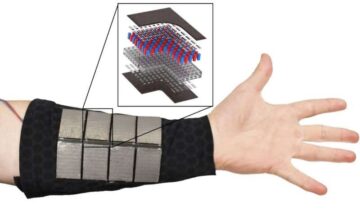Kaitlin Langram in Phys.Org:
 In the age of technology everywhere, we are all too familiar with the inconvenience of a dead battery. But for those relying on a wearable health care device to monitor glucose, reduce tremors, or even track heart function, taking time to recharge can pose a big risk.
In the age of technology everywhere, we are all too familiar with the inconvenience of a dead battery. But for those relying on a wearable health care device to monitor glucose, reduce tremors, or even track heart function, taking time to recharge can pose a big risk.
For the first time, researchers in Carnegie Mellon University’s Department of Mechanical Engineering have shown that a health care device can be powered using body heat alone. By combining a pulse oximetry sensor with a flexible, stretchable, wearable thermoelectric energy generator composed of liquid metal, semiconductors, and 3D printed rubber, the team has introduced a promising way to address battery life concerns. “This is the first step towards battery-free wearable electronics,” said Mason Zadan, Ph.D. candidate and first author of the research published in Advanced Functional Materials. The system, designed to achieve high mechanical and thermoelectric performance with seamless materials integration, features advancements in soft-materials, TEG array design, low energy circuit board design, and on-board power management.
More here.
Enjoying the content on 3QD? Help keep us going by donating now.
